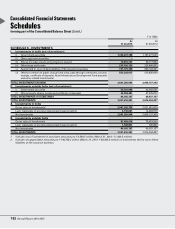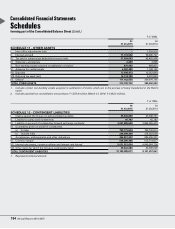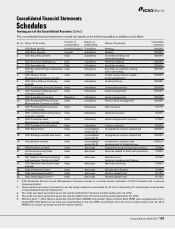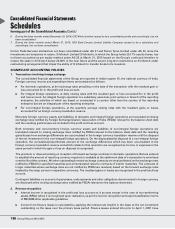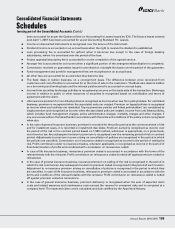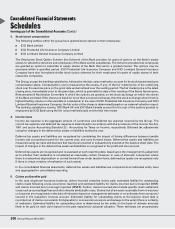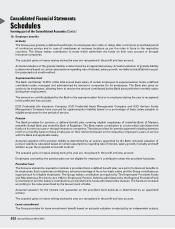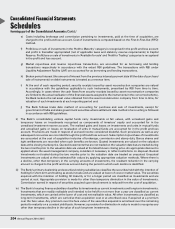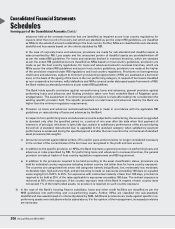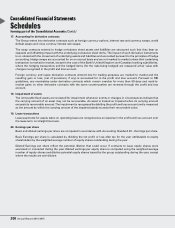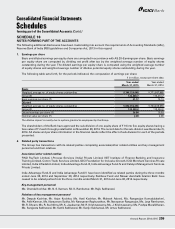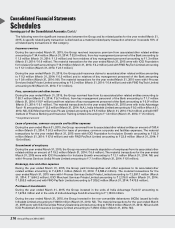ICICI Bank 2015 Annual Report Download - page 203
Download and view the complete annual report
Please find page 203 of the 2015 ICICI Bank annual report below. You can navigate through the pages in the report by either clicking on the pages listed below, or by using the keyword search tool below to find specific information within the annual report.
forming part of the Consolidated Accounts (Contd.)
Schedules
201Annual Report 2014-2015
Consolidated Financial Statements
revalidated on availability of further information. Claims IBNR represent that amount of claims that may have been
incurred during the accounting period but have not been reported or claimed. The claims IBNR provision also includes
provision, if any, required for claims IBNER. Estimated liability for claims IBNR/claims IBNER is based on an actuarial
estimate duly certified by the appointed actuary of the entity.
In the case of life insurance business, benefits paid comprise of policy benefits and claim settlement costs, if any. Death
and rider claims are accounted for on receipt of intimation. Survival and maturity benefits are accounted when due.
Withdrawals and surrenders under non linked policies are accounted on the receipt of intimation.
6. Liability for life policies in force
In the case of life insurance business, the liabilities for life policies in force are calculated in accordance with accepted
actuarial practice, requirements of Insurance Act, 1938 (amended by Insurance Laws (Amendment) Act, 2015) and
regulations notified by the Insurance Regulatory and Development Authority of India and Actuarial Practice Standards
of the Institute of Actuaries of India.
7. Reserve for unexpired risk
Reserve for unexpired risk is recognised net of re-insurance ceded and represents premium written that is attributable
and to be allocated to succeeding accounting periods for risks to be borne by the entity under contractual obligations
on contract period basis or risk period basis, whichever is appropriate. It is calculated on a daily pro-rata basis subject
to a minimum of 50.00% of the aggregated premium, written on policies during the twelve months preceding the
balance sheet date for fire, marine, cargo and miscellaneous business and 100.00% for marine hull business, on all
unexpired policies at balance sheet date, in accordance with the provisions of the Insurance Act, 1938.
8. Actuarial method and valuation
In the case of life insurance business, the actuarial liability on both participating and non-participating policies is
calculated using the gross premium method, using assumptions for interest, mortality, morbidity, expense and inflation,
and in the case of participating policies, future bonuses together with allowance for taxation and allocation of profits
to shareholders. These assumptions are determined as prudent estimates at the date of valuation with allowances for
adverse deviations. No allowance is made for expected lapses.
The greater of liability calculated using discounted cash flows and unearned premium reserves is held for the unexpired
portion of the risk for the non-unit liabilities of linked business and attached riders.
The unit liability in respect of linked business has been taken as the value of the units standing to the credit of
policyholders, using the Net Asset Value (NAV) prevailing at the valuation date.
An unexpired risk reserve and a reserve in respect of claims incurred but not reported are created, for one year
renewable group term insurance.
The interest rates used for valuing the liabilities are in the range of 4.47% to 5.39% per annum (previous year – 4.87%
to 5.77% per annum).
Mortality rates used are based on the published “Indian Assured Lives Mortality (2006 – 2008)”. Ultimate Mortality
Table for assurances and LIC 96-98 table for annuities, adjusted to reflect expected experience while morbidity rates
used are based on CIBT 93 table, adjusted for expected experience, or on risk rates supplied by reinsurers.
Expenses are provided for at current levels, in respect of renewal expenses, with no allowance for future improvements
but with an allowance for any expected worsening. Per policy renewal expenses for regular premium policies are
assumed to inflate at 4.49% (previous year – 4.84%).
9. Acquisition costs for insurance business
Acquisition costs are those costs that vary with and are primarily related to the acquisition of insurance contracts and
are expensed in the period in which they are incurred.



